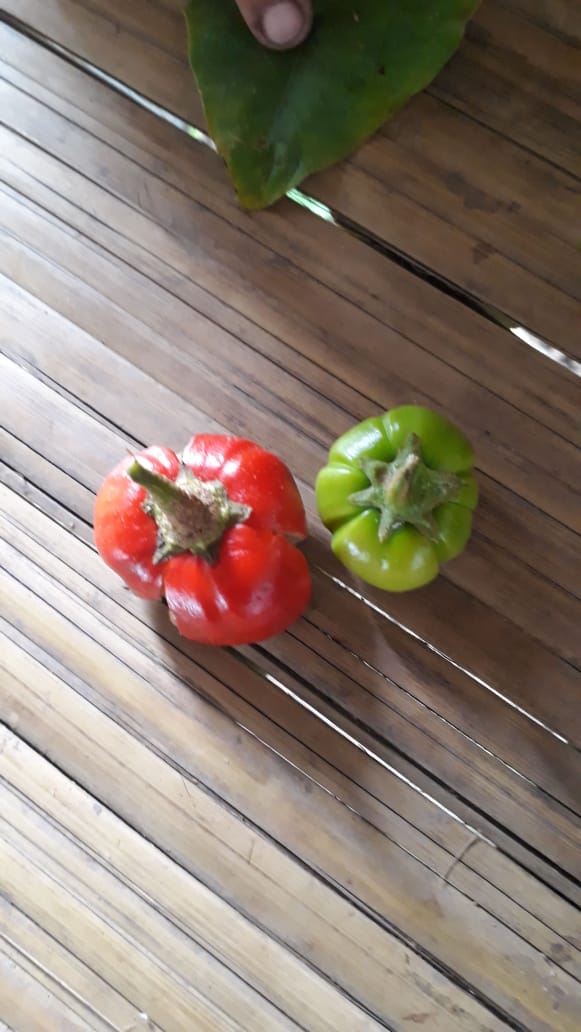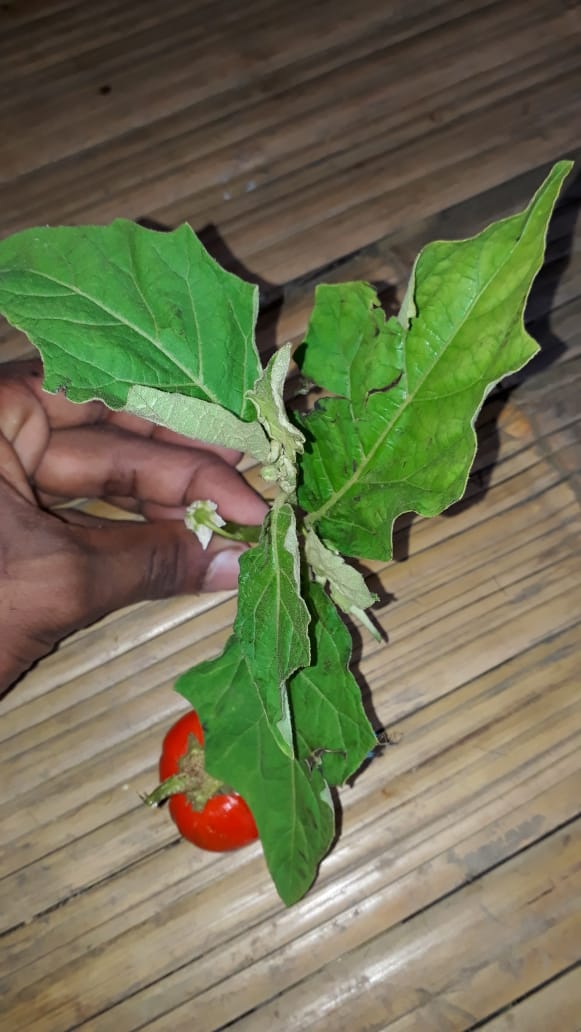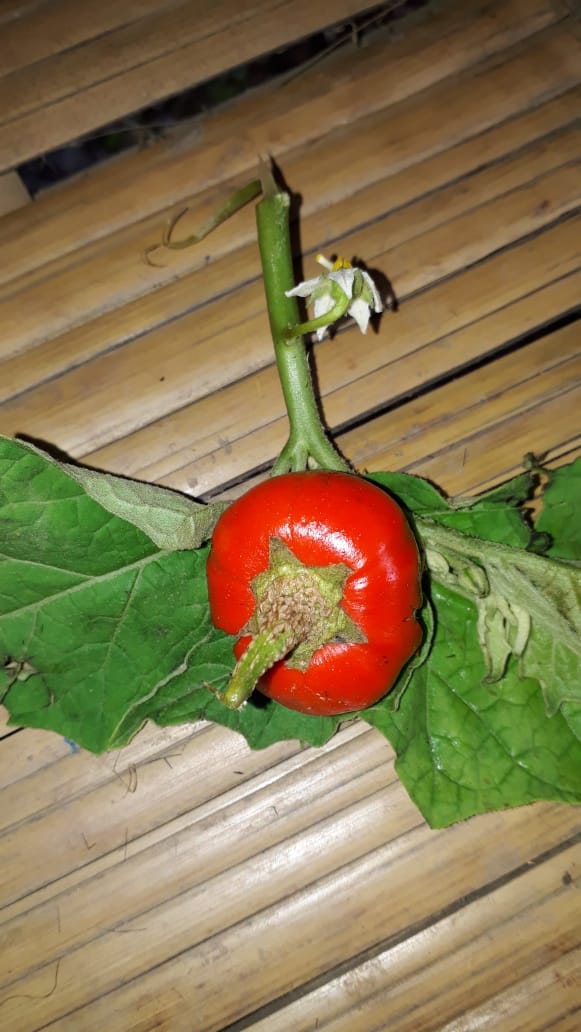|
Solanum aethiopicum L., Cent. Pl. II 2: 10 1756. (syn: Solanum gilo Raddi; Solanum integrifolium Lam.; Solanum texense Engelm. & A. Gray; Solanum undatum Jacq.);
. Native range is a cultigen from NE. Tropical Africa: Eritrea, Ethiopia; Introduced into: Angola, Assam, Benin, Brazil West-Central, Burkina, Cameroon, Central African Repu, Chad, China South-Central, China Southeast, Colorado, Congo, Egypt, Equatorial Guinea, Gabon, Ghana, Guinea, Gulf of Guinea Is., Illinois, Ivory Coast, Kentucky, Kenya, Liberia, Madagascar, Malawi, Mali, Mozambique, Niger, Nigeria, Rwanda, Senegal, Sierra Leone, Somalia, Sudan, Taiwan, Tanzania, Togo, Uganda, Vietnam, Windward Is., Zambia, Zaïre as per POWO; . Solanum aethiopicum, the bitter tomato, Ethiopian eggplant (ባሚያ), or nakati, is a fruiting plant of the genus Solanum mainly found in Asia and Tropical Africa. It is also known as Ethiopian nightshade,[1] garden eggs, and mock tomato. It is a popular vegetable in north-east India, and is known as khamen akhaba in Manipuri and samtawk in Mizo. These names are a result of its varied morphology, with ripe fruit often looking like a cross between an eggplant and a tomato, which are also from Solanum. In fact, the Ethiopian eggplant was so much confused with the ordinary eggplant that this was considered by some a variety violaceum of S. aethiopicum. Ethiopian eggplant may have originated from the domestication of Solanum anguivi. The scarlet eggplant, also known as Gilo or jiló, was long held to be a distinct species (S. gilo) but is nowadays generally considered to be a cultivar group of S. aethiopicum.
The leaves of Solanum aethiopicum are eaten as a leaf vegetable and are actually more nutritious than the fruit.
The highly variable fruit of the plant is eaten both raw and cooked and is becoming more popular as a cultivated crop. These fruits are usually harvested while still green, before the skin becomes thick. The bitterness depends on the levels of saponin it contains, some with a sweet flavor and others very bitter. When the berries mature, they turn bright red because of high carotene content.
Solanum aethiopicum is used as an ornamental in Asia.
Currently there is a large movement towards increased cultivation of Solanum aethiopicum in West Africa. It grows all year long and can produce high fruit yields. However, low germination rates are an obstacle to wider cultivation.
(From Wikipedia on 1.7.16)
.
Solanaceae Week: Solanum for ID_RKC_05042011. : 7 posts by 3 authors. Attachments (3) Pl help me to identify this Solanum sp. Tita baingan is Solanum kurzii, eaten as vegetable as per this source Few days back … had posted photographs of what he thought S. kurzii. It has much larger fruits. One of the two would be S. kurzii, which we will know only after detailed description from original publication is available.
In the mean time your fruits look much closer to Solanum diphyllum
efi thread Thanks for digging out into the species. Actually, I am also searching for the original description but not able to find yet. And I am also I think this is Solanum aethiopicum L. Here are more details from wiki: . Solanum sp. (Pl confirm the species)
Family: Solanaceae
Loc.: Itanagar, Arunachal Pradesh (ca 550 m) Uses: Fruits are edible. Bitter in taste. Local name: Tita Baigan/Cope Shape looks like S. diphyllum. Do you have any photograph of twig? I’ll search for the foto sir! It has purple flower and is commonly cultivated in Arunachal. I earlier thought it to be Solanum kurzii. But that plant is listed in Red Data Book. So m not sure still. The plant is Solanum melongena L. Even smallest fruits in S. melongena are not not that small. Also skin texture is different. The fruits of S. melongena elongated… it can be Solanum undatum or incanum A reply from another thread:
”I think this is Solanum aethiopicum L. Here are more details from wiki: https://en.wikipedia.org/wiki/Solanum_aethiopicum Requesting … and other experts to confirm.” Solanum aethiopicum L. ?? : 7 posts by 3 authors. Attachments (12) Location: Soureni, Mirik, India
Date: 18 May 2017
Altitude: 4200 ft.
I think appears so as per images at
Yes! Solanum aethiopicum. Common in NE India, and popularly known as ”तीता बैंगन (Tita-Baingan)” Rajnagar Kumarghat Tripura
Kindly identify
We are seeing at Tomato variety, or it is Capsicum? It could be Solanum sp. Solanum aethiopicum L. ?? Yes vegetable. Yes it is eaten as vegetable but it is bitter
It should be Solanum aethiopicum
. References: |
Solanum aethiopicum (Introduced)
Updated on December 24, 2024



